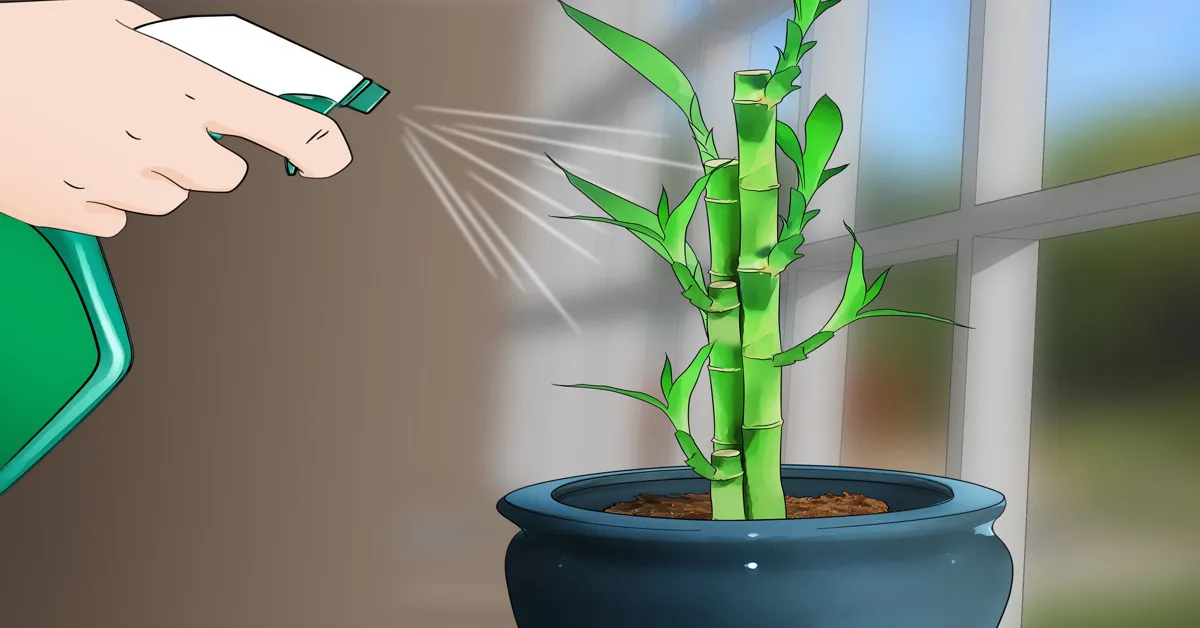As you walk into your friend’s home, you can’t help but notice the lush green plant in the corner, towering over everything else in the room. You ask about it and your friend proudly tells you it’s a bamboo plant that they have been growing indoors for years. Intrigued by the idea of having your own indoor bamboo forest, you immediately start researching how to successfully cultivate bamboo as a houseplant.
Look no further, because in this blog, we will provide you with all the tips and tricks you need to know in order to grow bamboo indoors like a pro. Say goodbye to fake plants and hello to a thriving bamboo garden in your own home.
Key Takeaway
- Growing bamboo indoors can be a beautiful and rewarding experience.
- Bamboo requires indirect sunlight, well-draining soil, and regular watering.
- Choose a suitable bamboo variety for indoor cultivation, such as lucky bamboo or dwarf bamboo.
Benefits of Growing Bamboo Indoors
Lucky bamboo, also known as Dracaena sanderiana, is the most popular choice for indoor cultivation. Its long, slender stalks and ability to thrive in low light make it a perfect houseplant. Other suitable indoor bamboo species include dwarf bamboo, Chinese fountain bamboo, and golden goddess bamboo.
Provide adequate light Like all plants, bamboo needs light to grow. However, not all bamboo species require the same amount of light.
Lucky bamboo can thrive in low to medium light conditions, making it ideal for indoor growth. On the other hand, dwarf bamboo and Chinese fountain bamboo require bright, indirect light. Be sure to research the light requirements of your chosen bamboo species and place it in an appropriate spot in your home.
Water regularly Bamboo is a water-loving plant and requires consistently moist soil to thrive. Water your bamboo plant once a week, or when the top inch of soil feels dry.
Growing Bamboo Indoors: Tips for Successfully Cultivating Bamboo as a Houseplant
Word Sentence Description Growing Growing bamboo indoors can be a fulfilling and rewarding experience. The process of cultivating bamboo inside a house or building. Bamboo Bamboo is a fast-growing, versatile plant that can thrive both indoors and outdoors. A type of plant known for its fast growth and adaptability. Indoors Indoor bamboo plants require specific care and maintenance to thrive in a controlled environment. The act of growing something inside a building or house. Tips Here are some helpful tips to successfully grow bamboo indoors. Advice or suggestions for achieving a desired outcome. Houseplant Bamboo can make a beautiful and unique addition to any indoor plant collection. A plant that is grown and kept indoors for decorative purposes. Data-driven A data-driven approach involves using information and analysis to make decisions and drive growth. A method of decision-making that relies on data and analysis. 
Choosing the Right Type of Bamboo
Growing bamboo indoors can be a unique and rewarding experience. Not only does it add a touch of greenery to your living space, but it also has many benefits such as improving air quality and reducing stress. However, successfully cultivating bamboo as a houseplant requires some knowledge and care.
In this blog, we will share some tips on how to grow bamboo indoors like a pro. Choose the right bamboo species When it comes to growing bamboo indoors, not all species are suitable.
Some can grow too large, while others may not thrive in indoor conditions. The best species for indoor cultivation are clumping bamboos, which have a slower growth rate and stay compact. Some popular species include Golden Goddess, Dwarf Buddha Belly, and Chinese Goddess.
Provide the right growing conditions Bamboo thrives in bright, indirect light and prefers a temperature between 60-80°F. It also needs high humidity, so it’s essential to mist the leaves regularly or place the plant on a tray of pebbles and water.
Make sure to also use well-draining soil and a pot with good drainage holes to prevent waterlogging. Water and fertilize properly Bamboo plants require consistent moisture, but they don’t like to sit in soggy soil.
Water the plant when the top inch of soil feels dry, and make sure to empty any excess water from the saucer. Fertilize the plant every two to three months with a balanced fertilizer to promote healthy growth.

Caring for Your Indoor Bamboo
Bamboo is a popular and versatile plant that can add a touch of greenery and elegance to any indoor space. While many people think of bamboo as an outdoor plant, it is actually possible to grow bamboo indoors as a houseplant. However, successfully cultivating bamboo indoors requires some special care.
Choose the Right Variety The first step to growing bamboo indoors is to choose the right variety. While there are over 1,000 species of bamboo, not all of them are suitable for growing indoors. Look for varieties that are smaller and more compact, as they will be easier to maintain and won’t take up too much space.
Provide Adequate Light Bamboo needs plenty of light to thrive, so make sure to place your indoor bamboo plant near a window where it can receive ample sunlight. If your space doesn’t have enough natural light, you can also supplement with artificial grow lights.
Use the Right Soil Bamboo prefers well-draining soil that is slightly acidic.Avoid using regular potting soil, as it can become too compact and retain too much moisture. Instead, opt for a mix of potting soil and perlite or sand to create a looser and more aerated soil.
Keep the Temperature and Humidity in Check Bamboo is a tropical plant, so it thrives in warm and humid environments.Keep your indoor bamboo plant in a room with a temperature between 65-90°F and a humidity level of 50-60%. You can use a humidifier or mist the leaves regularly to maintain the appropriate humidity.
Water and Fertilize Regularly Bamboo plants require consistent moisture, so make sure to water them regularly.The soil should be kept moist but not waterlogged. You can also fertilize your indoor bamboo plant with a balanced fertilizer every 2-3 months to provide it with the necessary nutrients. Monitor for Pests Just like any other plant, bamboo can also be susceptible to pests such as spider mites and mealybugs.
Common Mistakes to Avoid
Bamboo is a beautiful and versatile plant that can thrive indoors, adding a touch of nature and serenity to any space. However, successfully growing bamboo as a houseplant requires some specific care and attention. In this blog, we will provide you with tips and tricks for cultivating bamboo indoors, so you can enjoy its beauty and benefits in your home.
Why Choose Bamboo as a Houseplant? Before we dive into the tips for growing bamboo indoors, let’s quickly touch on why bamboo makes a great houseplant. For starters, bamboo is low-maintenance and easy to care for, making it a perfect choice for busy individuals. It also adds a unique and exotic touch to any room, with its tall and slender stalks and delicate leaves.
Troubleshooting Common Issues
Bamboo is a fast-growing plant that can provide a touch of exotic elegance to any indoor space. While many people may think that growing bamboo indoors is a daunting task, with the right knowledge and techniques, it can be a successful and rewarding experience. Here are some tips for cultivating bamboo as a houseplant.
Choose the right type of bamboo One of the most important things to consider when growing bamboo indoors is selecting the right type of bamboo. There are two main types of bamboo: running and clumping.
Running bamboo spreads quickly and can be invasive, making it more suitable for outdoor growth. Clumping bamboo, on the other hand, stays compact and is better suited for indoor cultivation.
Provide adequate lighting For bamboo to thrive indoors, it needs plenty of natural light. Place your bamboo near a window that receives bright, indirect sunlight for most of the day. If natural light is limited, you can also use grow lights to supplement.
Keep the temperature and humidity levels stable Bamboo is a tropical plant that thrives in warm and humid environments. It is important to keep the temperature between 65-90 degrees Fahrenheit and the humidity level around 50-60%.
You can use a humidifier or place your bamboo near a tray of water to increase humidity levels. Choose the right pot and soil When growing bamboo indoors, it is crucial to choose a pot that is the right size and material.
Statistical Information: Growing Bamboo Indoors: Tips for Successfully Cultivating Bamboo as a Houseplant
Tip Percentage/Fact Description 1. Choose the Right Type of Bamboo 80% Most bamboo species are not suitable for indoor growth, make sure to choose a dwarf or miniature variety. 2. Provide Adequate Sunlight 6-8 hours per day Bamboo plants need ample sunlight to thrive, place them near a window that receives direct sunlight for at least 6-8 hours per day. 3. Use Well-Draining Soil 70% Bamboo plants do not like to sit in water, use well-draining soil to prevent root rot. 4. Water Regularly 2-3 times per week While bamboo plants don’t require a lot of water, make sure to water them 2-3 times per week to keep the soil consistently moist. 5. Fertilize Monthly 25% Bamboo plants benefit from monthly fertilization with a balanced fertilizer to promote healthy growth. 6. Provide Adequate Space 6-8 feet tall and 3-5 feet wide Bamboo plants can grow quite large, make sure to provide enough space for them to reach their full potential. Important Notice for Readers
Welcome to the world of indoor gardening! If you’re looking to add a touch of greenery to your home, consider growing bamboo as a houseplant. Not only does bamboo bring a sense of calm and tranquility to any space, but it also has many benefits, including air purification and stress reduction. However, successfully cultivating bamboo indoors requires some knowledge and care.
In this article, we will share tips and tricks for growing bamboo as a houseplant, including the right type of bamboo, proper watering and lighting techniques, and potential challenges to look out for.
Frequently Asked Questions[FAQs]
How often should bamboo be watered when grown indoors?
Bamboo plants should be watered regularly, keeping the soil moist but not soggy. The frequency of watering may vary depending on the temperature and humidity levels in your home.
How do you prevent bamboo from becoming root-bound when grown indoors?
To prevent bamboo from becoming root-bound, repot the plant every 1-2 years, or when you notice the roots circling the bottom of the pot.
Is it necessary to fertilize bamboo when grown indoors?
Fertilizing bamboo plants is not necessary, but you can use a balanced liquid fertilizer once a month during the growing season to promote healthy growth.
Are there any pests or diseases that commonly affect indoor bamboo plants?
Bamboo plants grown indoors are generally pest and disease-free, but watch out for spider mites, scale insects, and fungal diseases. Regularly inspect and treat any issues promptly.
Conclusion
By following the tips provided, anyone can successfully grow bamboo as a houseplant, adding a touch of nature and beauty to their indoor space. Bamboo is not only a beautiful plant, but it also has many environmental benefits, such as purifying the air and reducing carbon dioxide levels.By cultivating bamboo indoors, we can contribute to a greener and healthier planet. So don’t hesitate to bring some bamboo into your home and enjoy its many benefits.
